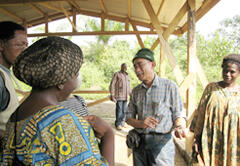Establishment of Sustainable Livelihood Strategies and Natural Resource Management in Tropical Rain Forest and its Surrounding Areas of Cameroon: Integrating the Global Environmental Concerns with Local Livelihood Needs
Bioresources
 Republic of Cameroon
Republic of Cameroon
Establishment of Sustainable Livelihood Strategies and Natural Resource Management in Tropical Rain Forest and its Surrounding Areas of Cameroon: Integrating the Global Environmental Concerns with Local Livelihood Needs
Protecting Tropical Rainforest through Raising Living Standards of the Local Population
Principal Investigator
ODA Recipient Country
Republic of Cameroon
Research Institutions in Japan
Kyoto University
Research Institutions in Counterpart Country
Institute of Agricultural Research for Development (IRAD) / University of Yaounde I / University of Dschang / University of Douala
Adoption fiscal year
FY 2010
Research Period
5 Years
Overview of the Research Project
Preserving carbon stock and biodiversity of tropical rainforests
The huge coverage of tropical rain forests in the Congo basin plays a vital role in preserving carbon stock and biodiversity. However, about 60 million people in this region also depend on the rainforest for fuel, food, medicines and construction materials. This project aims at protecting troical rainforests, while also raising the living standards of local populations through promotion of nontimber forest products (NTFPs). Local populations take part in surveys of utilization and ecology of NTFPs, and these activities provide a sound basis for establishing systems for sustainable use of forest resources by community organizations.
Raising living standards by bolstering traditional cassava production
We are aiming to raise living standards by bolstering cassava production and establishing market channels for processed cassava, and for alcoholic and other beverages manufactured from surplus cassava produce. We will also reassess non-timber forest products as an alternative to the over-exploitation of timber. The project's findings will be used to construct sustainable land use and environmental protection models for both the forest and its contact zones. The work done up to FY2012 revealed seasonal production changes of NTFPs, as well as wildlife population density. In addition, the results of local experiments with improved cassava varieties showed that it is possible to double the cassava yield, and new varieties have been distributed to all village households through stem cuttings.
Photo gallery

The people of Gribe, a mix of hunters/gatherers and farmers, were asked to participate in discussions about the construction of a base for researching non-timber forest products.
Research Project Web site
Press Release
Links
Projects
Contact Us
Japan Science and Technology Agency (JST)
Department of International Affairs
SATREPS Group
TEL : +81-3-5214-8085
Related articles by Category
- Bioresources
Bioresources

 Republic of Indonesia
Republic of Indonesia
Promoting the blue economy by utilizing seaweed resources!
Development of Sustainable Seaweed Based Functional Products for Promoting Blue Economy
- Cameroon
Environment / Energy
(Global-scale environmental issues)
 Republic of Cameroon
Republic of Cameroon
Creating the future of African tropical rainforests with local people
Co-creation of Innovative Forest Resources Management Combining Ecological Methods and Indigenous Knowledge
- Africa
Environment / Energy
(Global-scale environmental issues)
 Arab Republic of Egypt
Arab Republic of Egypt
Contributing to the reduction of marine plastic litter and the establishment of a circular economy!
Utilization of Agricultural Wastes for Plastic Alternatives Productions to Establish a Circular Economy
- SDGs : Goal.2
Bioresources

 Republic of Indonesia
Republic of Indonesia
Achieve sustainable vegetable production in tropical regions using advanced breeding technology!
Breeding Innovation in Chili Pepper and Tomato to Accelerate Sustainable Vegetable Production in Tropical Regions























